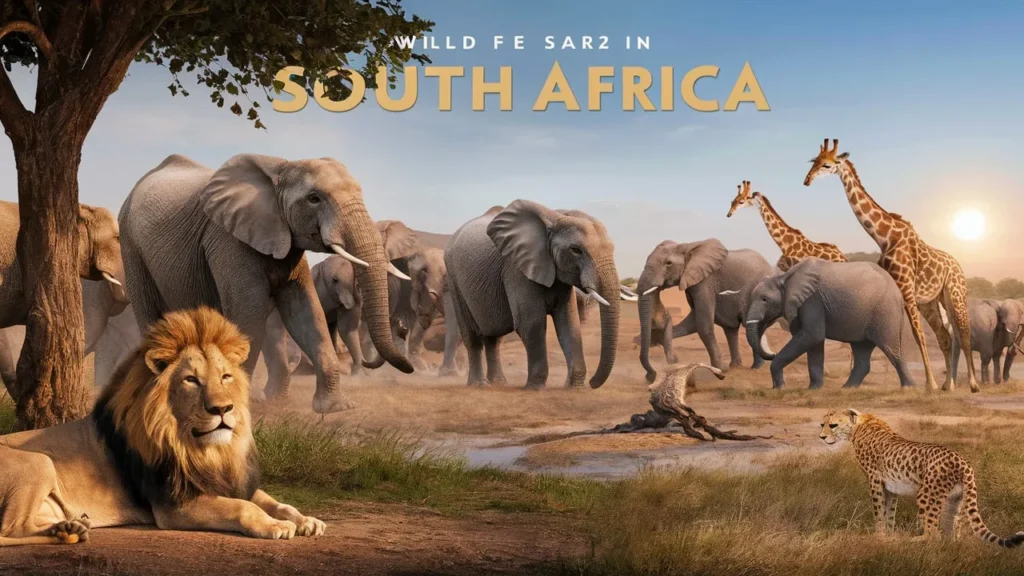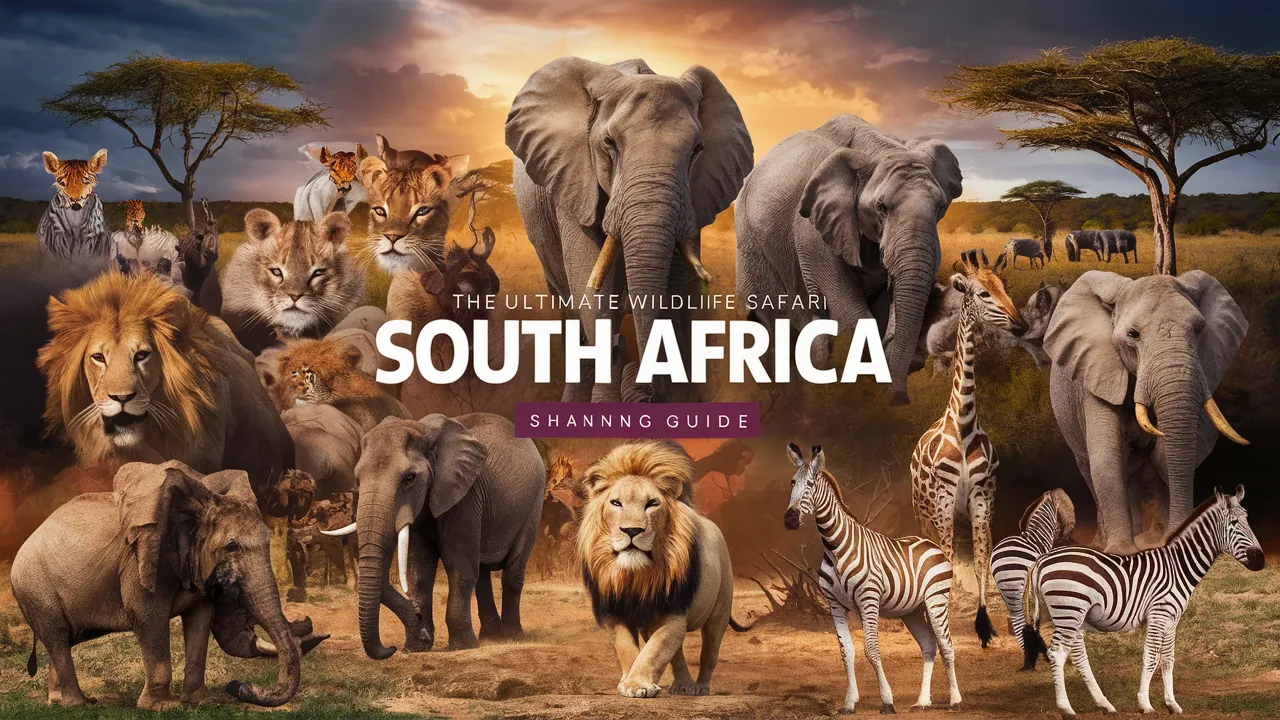Introduction
Embarking on a wildlife safari in South Africa is not just a vacation; it is an experience that can transform your understanding of the natural world. This guide is designed to provide you with insights and practical tips to ensure your safari is unforgettable, allowing you to witness the country’s rich biodiversity, vibrant landscapes, and commitment to conservation. From the unique wildlife to the most essential gear, every detail will help you plan the adventure of a lifetime.
Understanding the South African Safari Experience
South Africa is renowned for its exceptional safari experiences, blending luxury travel with a deep connection to nature. The vastness of its landscapes provides a diverse range of ecosystems, each hosting unique wildlife. At the heart of a safari lies the pursuit of the “Big Five”: lions, leopards, elephants, rhinoceroses, and buffalo. However, the wonder of a safari extends far beyond these iconic animals.
The Unique Wildlife of South Africa
While the Big Five are a significant attraction, South Africa is home to a myriad of other species. From majestic giraffes gracefully munching on acacia trees, to stealthy cheetahs sprinting across the plains, each encounter adds a layer to your safari experience. Additionally, the country boasts unique bird species, reptiles, and a rich variety of flora, making it a haven for nature enthusiasts.
You will be enthralled by the chance to witness wildlife interactions within their natural habitats, whether it’s a herd of elephants bathing in a waterhole, or the playful antics of meerkats standing guard. Each moment offers a new story waiting to unfold.
The Role of Conservation in South African Safaris
Conservation is integral to the safari experience in South Africa. Many parks and reserves operate under a model that prioritizes protecting wildlife and their habitats. Tourists often contribute to these efforts simply by visiting; your fees support anti-poaching initiatives, habitat restoration, and community education programs.
Understanding the conservation challenges these animals face, such as habitat loss and poaching, enhances your safari. You can become a part of the greater narrative of preservation, ensuring that future generations can experience the same wonders.
Planning Your South African Safari
Planning is crucial for an unforgettable safari. With so many options available, it’s essential to approach your trip with clear objectives, whether that’s luxury, adventure, or a focus on conservation.
Best Time to Visit for a Safari
The ideal time for a safari largely depends on what you want to see and experience. The dry winter months, from May to September, are popular as animals are easier to spot near water sources. This period also has milder temperatures, perfect for day excursions.
Conversely, the wet summer months, from October to March, bring lush landscapes, vibrant flora, and active animal behavior, including births and mating rituals. Choosing your timing will significantly impact your safari experience.
Choosing the Right Safari Package
When selecting a safari package, consider your preferences for accommodation and the type of excursions offered. Options range from luxury lodges to rustic camps, each providing a distinct experience. Some packages focus on guided game drives, while others may include walking safaris, birdwatching tours, or even cultural experiences in nearby communities.
Additionally, consider the size of the tour group. Smaller groups often allow for a more personalized experience, enhancing your opportunity to interact and connect with both the guides and the surroundings.
Read More: Essential Costa Rica Travel Tips for a Perfect Vacation
Essential Safari Gear and Preparation
Preparation plays a vital role in having an enjoyable safari. Proper gear will ensure you are comfortable and ready to embrace every moment of your adventure.
What to Pack for a Safari
Your packing list should include essentials such as:
- Lightweight, breathable clothing in neutral colors to blend into the environment.
- Durable footwear for walking or hiking.
- A good pair of binoculars for wildlife watching.
- Sun protection: hats, sunscreen, and sunglasses.
- A camera with a zoom lens to capture those memorable moments.
Don’t forget your basic toiletries and personal items, along with insect repellent to minimize bites from pesky mosquitoes.
Health and Safety Tips for a Safari
Health and safety should be a top priority while on safari. Consult your physician about vaccinations and medications needed for malaria prevention, particularly if you are visiting areas where it is prevalent.
Familiarize yourself with safety protocols, especially when venturing outside of vehicles. Always listen to your guide’s instructions, as they are trained to handle wildlife encounters and ensure your safety.

Exploring South Africa’s Top Safari Destinations
South Africa’s diverse parks and reserves each offer unique experiences, showcasing the essence of what a safari can be. From the iconic Kruger to lesser-known gems, every destination promises adventure and discovery.
Kruger National Park: A Closer Look
Kruger National Park is one of Africa’s largest game reserves, stretching over 19,000 square kilometers. It offers a high density of wildlife, making it a premier destination for safari enthusiasts. The park provides a variety of accommodations and self-drive options, allowing visitors to explore at their own pace.
In Kruger, you can witness various ecosystems, from savannah grasslands to dense bushveld, all teeming with life. Night drives are often available, providing a chance to see nocturnal animals on the prowl.
The Magic of Addo Elephant National Park
Addo Elephant National Park is famous for its elephant population, with over 600 elephants roaming freely. The park’s diverse landscapes, which include mountains, scrublands, and citrus farms, create a unique backdrop for your adventure.
In addition to elephants, visitors can spot lions, rhinos, and a variety of bird species. The park’s commitment to conservation and educational outreach provides an enriching experience for all visitors, making it an excellent choice for those passionate about wildlife protection.
Making the Most of Your Safari Experience
Aside from witnessing extraordinary wildlife, there are various ways to enhance your overall safari experience. Engaging with the environment and respecting its inhabitants goes a long way in creating a memorable journey.
Photography Tips for Capturing Wildlife
A good camera is essential for any safari, but understanding how to use it effectively is just as important. Here are some tips:
- Use a zoom lens to capture distant animals without disturbing them.
- Early mornings or late afternoons offer the best light for photography.
- Stay patient; wildlife photography often requires time to capture the perfect shot.
Consider taking a photography workshop or learning from your guide, who can offer insights into the best techniques and settings for various conditions.
Respecting Wildlife and Their Habitats
Lastly, practicing respect towards wildlife and their habitats is paramount. Always maintain a safe distance from animals, and never feed or provoke them. Your actions can have significant impacts on their behavior and wellbeing.
By prioritizing responsible tourism, you contribute to the conservation of wildlife and their ecosystems. In turn, you will foster a deeper connection with nature, ultimately enriching your safari experience.
Conclusion
A wildlife safari in South Africa transcends the mere act of viewing animals; it is about understanding, respecting, and preserving the beauty of our planet. Armed with the right knowledge and gear, you are now ready to embark on an adventure that will create memories to last a lifetime.
FAQs
What is a wildlife safari in South Africa?
A wildlife safari in South Africa involves exploring national parks and reserves to observe and experience the country’s diverse wildlife in their natural habitats.
Which national parks are best for safaris in South Africa?
Popular national parks for wildlife safaris include Kruger National Park, Addo Elephant National Park, and Pilanesberg Game Reserve.
What animals can I expect to see on a safari?
Visitors can expect to see the Big Five (lion, leopard, elephant, buffalo, and rhinoceros) as well as a variety of other wildlife, including zebras, giraffes, and more.
When is the best time to go on a safari in South Africa?
The best time for a safari is typically during the dry winter months (May to September) when animals are more active and easier to spot.
What types of safari experiences are available?
Safari experiences vary from guided game drives, walking safaris, and horseback safaris to luxury lodge stays and budget-friendly camping options.
